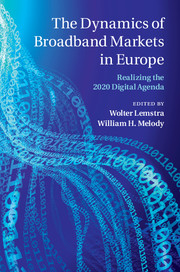Refine search
Actions for selected content:
3527 results in Wireless Communications
Dedication
-
- Book:
- Introduction to Communication Systems
- Published online:
- 28 May 2018
- Print publication:
- 24 November 2014, pp v-vi
-
- Chapter
- Export citation
5 - Probability and random processes
-
- Book:
- Introduction to Communication Systems
- Published online:
- 28 May 2018
- Print publication:
- 24 November 2014, pp 207-314
-
- Chapter
- Export citation
Frontmatter
-
- Book:
- Introduction to Communication Systems
- Published online:
- 28 May 2018
- Print publication:
- 24 November 2014, pp i-iv
-
- Chapter
- Export citation
Acknowledgements
-
- Book:
- Introduction to Communication Systems
- Published online:
- 28 May 2018
- Print publication:
- 24 November 2014, pp xviii-xx
-
- Chapter
- Export citation
4 - Digital modulation
-
- Book:
- Introduction to Communication Systems
- Published online:
- 28 May 2018
- Print publication:
- 24 November 2014, pp 155-206
-
- Chapter
- Export citation
Epilogue
-
- Book:
- Introduction to Communication Systems
- Published online:
- 28 May 2018
- Print publication:
- 24 November 2014, pp 512-518
-
- Chapter
- Export citation
Contents
-
- Book:
- Introduction to Communication Systems
- Published online:
- 28 May 2018
- Print publication:
- 24 November 2014, pp vii-xii
-
- Chapter
- Export citation

The Dynamics of Broadband Markets in Europe
- Realizing the 2020 Digital Agenda
-
- Published online:
- 05 November 2014
- Print publication:
- 23 October 2014
6 - Denmark
- from Part 2 - Case studies
-
-
- Book:
- The Dynamics of Broadband Markets in Europe
- Published online:
- 05 November 2014
- Print publication:
- 23 October 2014, pp 110-135
-
- Chapter
- Export citation
Part 1 - European Union context
-
- Book:
- The Dynamics of Broadband Markets in Europe
- Published online:
- 05 November 2014
- Print publication:
- 23 October 2014, pp 23-52
-
- Chapter
- Export citation
1 - Introduction
-
-
- Book:
- The Dynamics of Broadband Markets in Europe
- Published online:
- 05 November 2014
- Print publication:
- 23 October 2014, pp 1-11
-
- Chapter
- Export citation
Appendix 1 - Glossary
- from Part 4 - Appendices
-
- Book:
- The Dynamics of Broadband Markets in Europe
- Published online:
- 05 November 2014
- Print publication:
- 23 October 2014, pp 387-394
-
- Chapter
- Export citation
Part 2 - Case studies
-
- Book:
- The Dynamics of Broadband Markets in Europe
- Published online:
- 05 November 2014
- Print publication:
- 23 October 2014, pp 53-350
-
- Chapter
- Export citation
10 - Italy
- from Part 2 - Case studies
-
-
- Book:
- The Dynamics of Broadband Markets in Europe
- Published online:
- 05 November 2014
- Print publication:
- 23 October 2014, pp 201-224
-
- Chapter
- Export citation
12 - Spain
- from Part 2 - Case studies
-
-
- Book:
- The Dynamics of Broadband Markets in Europe
- Published online:
- 05 November 2014
- Print publication:
- 23 October 2014, pp 249-270
-
- Chapter
- Export citation
11 - France
- from Part 2 - Case studies
-
-
- Book:
- The Dynamics of Broadband Markets in Europe
- Published online:
- 05 November 2014
- Print publication:
- 23 October 2014, pp 225-248
-
- Chapter
- Export citation
The Dynamics of Broadband Markets in Europe - Half title page
-
- Book:
- The Dynamics of Broadband Markets in Europe
- Published online:
- 05 November 2014
- Print publication:
- 23 October 2014, pp i-ii
-
- Chapter
- Export citation
Part 3 - Analysis
-
- Book:
- The Dynamics of Broadband Markets in Europe
- Published online:
- 05 November 2014
- Print publication:
- 23 October 2014, pp 351-384
-
- Chapter
- Export citation
Appendix 2 - Quantitative analysis of broadband performance
- from Part 4 - Appendices
-
-
- Book:
- The Dynamics of Broadband Markets in Europe
- Published online:
- 05 November 2014
- Print publication:
- 23 October 2014, pp 395-397
-
- Chapter
- Export citation
5 - Belgium: Flanders
- from Part 2 - Case studies
-
-
- Book:
- The Dynamics of Broadband Markets in Europe
- Published online:
- 05 November 2014
- Print publication:
- 23 October 2014, pp 85-109
-
- Chapter
- Export citation
